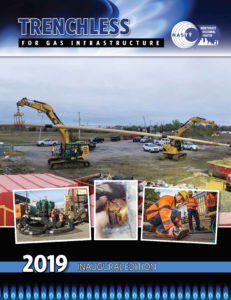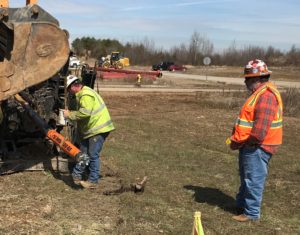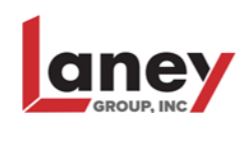Industry News, trenchless people, trenchless projects
 The Northeast Chapter of NASTT has launched a magazine that will be beneficial to the gas industry across the United States.
The Northeast Chapter of NASTT has launched a magazine that will be beneficial to the gas industry across the United States.
The inaugural issue of Trenchless for Gas Infrastructure magazine is now available as a complementary download. Trenchless for Gas Infrastructure magazine provides understanding, knowledge and technical innovations regarding the specific application of trenchless technology methods for gas distribution and transmission networks.
Trenchless for Gas Infrastructure is focused on the utility and application of trenchless methods in gas distribution pipeline repair and new construction programs. Content includes articles and case studies demonstrating the benefits of using trenchless technology to repair replace and upgrade gas distribution networks.
The magazine is distributed to senior gas operations and construction executives, engineers and consultants, reaching gas utility LDCs across the US. It is also available as a free download on the NASTT website.
Industry News, trenchless people
 THOMPSON, CONNECTICUT USA: Numa, the world’s leading drilling technology provider, has announced the addition of Gregg Hayes as Product Manager HDD. Gregg is based in New York and will head up business development, service, and support of Numa’s horizontal directional drilling (HDD) products. The position will require him to grow direct and dealer sales of Numa’s horizontal hammers, bits, and drilling systems.
THOMPSON, CONNECTICUT USA: Numa, the world’s leading drilling technology provider, has announced the addition of Gregg Hayes as Product Manager HDD. Gregg is based in New York and will head up business development, service, and support of Numa’s horizontal directional drilling (HDD) products. The position will require him to grow direct and dealer sales of Numa’s horizontal hammers, bits, and drilling systems.
Gregg is a recognized expert in HDD and comes to Numa with 20 years of experience in the drilling industry. For the past 5 years, he was a top HDD salesperson selling into multiple US markets while also focusing on the further development of horizontal rock drilling products. Previously, he served in various sales and management roles for companies selling tooling, drilling fluids, bits, reamers, rock tools, swivels, etc. His experience and background provide drillers with a wealth of knowledge and insight.
“Gregg is one of the foremost experts in HDD with a proven track history of teaching drillers the most effective ways to drill using pneumatic hammers and bits in horizontal drilling applications,” said Numa Vice President of Sales, Neal Kuszewski. “He is a great addition to our team and further demonstrates Numa commitment to providing the best drilling resources in the industry.”
Gregg commented, “Throughout my career, I have recognized Numa to be the industry leader in rock drilling products. I am very excited to join Numa and continue their long history of providing customers with the right products, expertise, and support.”
ABOUT NUMA
Numa is the world’s leading drilling technology provider, dedicated to ongoing product innovation and results-oriented consistency. We’ve built a strong legacy of high quality, U.S. made hammers and bits for drilling holes 3½ – 50½ inches (89 -1283 mm) in diameter. With over 100 hammer and bit products serving 11 different industries, our products are capable of drilling vertical, horizontal, and reverse circulation holes in hard rock and unconsolidated formations.
Industry News, trenchless people
 Brownsdale, MN – April 11, 2019 – Akkerman Inc., a premier trenchless underground construction systems manufacturer, attained the International Organization for Standardization (ISO) ISO 9001:2015 for its quality management system at its sole manufacturing facility in Brownsdale, MN.
Brownsdale, MN – April 11, 2019 – Akkerman Inc., a premier trenchless underground construction systems manufacturer, attained the International Organization for Standardization (ISO) ISO 9001:2015 for its quality management system at its sole manufacturing facility in Brownsdale, MN.
Following an independent audit conducted by SAI Global, the certificate was issued on January 18, 2019.
The scope of the certification applies to the design, manufacture, sales, and services of on line and on grade tunneling and pipe jacking products for the underground sewer, water, gas, and electrical utilities industries.
Akkerman embarked on the implementation of its quality management system in 2015 with consulting assistance from Enterprise Minnesota who was integral to the system’s execution.
Justin Akkerman, Akkerman operations manager, remarks, “Minnesota Occupational Safety and Health recognized us through the Minnesota Safety and Health Achievement Recognition Program for our safety program in 2010. Having our management system certified to ISO 9001:2015 was a natural progression to strengthen the business.”
Akkerman furthers, “Not only does our comprehensive quality management system benefit our employees through procedure efficiencies and repeat-ability, but our customers can also feel confident in knowing that the equipment that we manufacture is subject to the highest standards and continuous improvement at every step in the manufacturing process. Our ISO 9001:2015 Quality Management System ensures that from design conception to final product testing, our equipment is produced with quality and value at the forefront.”
Established in 1973, Akkerman develops, manufactures and supports advanced guided boring, microtunneling, pipe jacking, sliplining and tunneling underground construction solutions that accurately install a variety of pipe in an extensive range of ground conditions and project challenges. Akkerman systems are available for purchase, lease-to-purchase, or rent from our rental fleet. Contact us to partner with you on your next project at 800.533.0386 and visit akkerman.com.
Industry News, trenchless people
 Active NASTT volunteer, instructor and past Board Chair, George Ragula recently visited the NASTT Student Chapter at Rutgers University in New Jersey to speak with them about trenchless technology and the gas industry.
Active NASTT volunteer, instructor and past Board Chair, George Ragula recently visited the NASTT Student Chapter at Rutgers University in New Jersey to speak with them about trenchless technology and the gas industry.
George stated that is was a very interactive and informative session for the students. He gave a detailed presentation of the 36” world record gas CIPL renewal and there were a lot of questions. The students were curious as to how and when George got started in trenchless, his motivation and how he came up through the ranks at NASTT when he first joined in 1993.
The students also expressed interest in developing a trenchless curriculum as part of a Masters course and he offered his help and guidance. They discussed the fast growing pace of this particular industry. The students feel positive about this niche in the construction industry and many hope to pursue a career in trenchless.
Industry News, trenchless people
 Laney Group, Inc. (“Laney”) and Innovative Pipeline Crossings, Inc. (“IPC”) have signed a teaming agreement, under which they will cooperatively pursue projects that require a combination of their services and expertise. Laney provides an integrated suite of Engineering, HDD, Direct Pipe® and Project Management solutions internationally. IPC, a Bothar Group Company, provides Direct Pipe®, Auger Boring, Pipe Jacking and Microtunneling solutions throughout Canada. Laney and
Laney Group, Inc. (“Laney”) and Innovative Pipeline Crossings, Inc. (“IPC”) have signed a teaming agreement, under which they will cooperatively pursue projects that require a combination of their services and expertise. Laney provides an integrated suite of Engineering, HDD, Direct Pipe® and Project Management solutions internationally. IPC, a Bothar Group Company, provides Direct Pipe®, Auger Boring, Pipe Jacking and Microtunneling solutions throughout Canada. Laney and
IPC will strategically augment each other’s existing capabilities in their respective markets.
 Laney Group, Inc. has a long history and is an established leader in HDD and Direct Pipe® Installations internationally. As part of a recent management change and a industry acquisition, Laney now delivers integrated Engineering, Procurement, Construction and Project Management Solutions to serve our clients in the trenchless industry and beyond… Worldwide. Per Todd Miller, Laney Group CEO, “First and foremost, IPC and Bothar are both world-class companies led by world-class leaders. We are thrilled to be partnering with IPC to be able to deliver a comprehensive suite of trenchless solutions to our
Laney Group, Inc. has a long history and is an established leader in HDD and Direct Pipe® Installations internationally. As part of a recent management change and a industry acquisition, Laney now delivers integrated Engineering, Procurement, Construction and Project Management Solutions to serve our clients in the trenchless industry and beyond… Worldwide. Per Todd Miller, Laney Group CEO, “First and foremost, IPC and Bothar are both world-class companies led by world-class leaders. We are thrilled to be partnering with IPC to be able to deliver a comprehensive suite of trenchless solutions to our
international clients in a world-class manner. We look forward to the next steps”.
With a proven track record of successful projects, IPC is currently one of the largest Direct Pipe® contractors in Canada. Notable accomplishments include simultaneous DPI operations in British Columbia and Ontario in 2017 and a Performance World Record for drilling 218m in 24hours.
IPC was acquired by the Bothar Group of Companies in November 2018, one of the largest Microtunneling contractors in the world. Since the acquisition, IPC has been expanding its range of operations into other disciplines such as Auger Boring, Pipe Jacking and Microtunneling.
This cooperation agreement allows both companies to collaborate on a full range of trenchless installation technologies and solutions in North America and internationally. Combined technical experience, access to specialized equipment and utilization of engineering knowledge and experience will enable both parties to provide the best technical and most costeffective solutions to clients across the range of trenchless solutions.
Peter Hennig – CEO of IPC, Inc.: “A trustful relationship between the senior management of both entities will allow for a successful future in this alliance. I’m very excited for both of our companies and our employees. New opportunities, paired with each of our experiences and available resources, will open up the path to exciting new horizons.”
For further information, please contact:
IPC Contact details: info@ipipecrossings.com
Laney Group, Inc. contact details: info@laneydrilling.com
Industry News, trenchless people
 RICHMOND, VA – Matrix Capital Markets Group, Inc. (“Matrix”), a leading, independent investment bank, is pleased to announce the sale of Chesapeake, VA-based Tri-State Utilities Company (the “Company” or “Tri-State”) to Hoffman Southwest Corp. (“HSW”), a portfolio company of ORIX Capital Partners LLC (“ORIX”).
RICHMOND, VA – Matrix Capital Markets Group, Inc. (“Matrix”), a leading, independent investment bank, is pleased to announce the sale of Chesapeake, VA-based Tri-State Utilities Company (the “Company” or “Tri-State”) to Hoffman Southwest Corp. (“HSW”), a portfolio company of ORIX Capital Partners LLC (“ORIX”).
Founded in 1990 by Steve McSweeney, Tri-State is a leading, award-winning, regional provider of trenchless repair, rehabilitation, inspection, and other maintenance services to the municipal utility market. After nearly two decades of successfully providing technical services to support the maintenance needs of its customer base, Mr. McSweeney passed leadership of the Company’s operations to his two sons, Andy McSweeney and Joe McSweeney, in 2007. The change in leadership coincided with a period of rapid expansion for Tri-State, as the McSweeney brothers invested heavily in fleet and human capital in order to establish the Company as a market leader in trenchless utility rehabilitation throughout the Mid-Atlantic and Southeast. As a result of those investments, Tri-State maintains long-term sewer and stormwater contracts with an enviable list of blue-chip customers. Additionally, the Company has received recognition from its customers, vendors, and the broader industry for its exceptional safety credentials, technical expertise, increasingly diverse suite of services, and expanding geographic reach.
Andy McSweeney, President of Tri-State commented, “We are thrilled to be partnering with the HSW team to expand the breadth of services we’re able to offer our valued customer base. When Joe and I began contemplating a possible ownership transition, it was critical that we find a group that shared our Company’s values and commitment to growth. We feel confident that the HSW and ORIX teams are precisely the partners that share this vision.” Joe McSweeney, Chief Executive Officer of Tri-State added, “I have no doubt that HSW will help us build on the tremendous foundation that our father established and Andy and I were fortunate enough to continue. As shareholders in the combined entity, we are looking forward to personally maintaining the level of service and responsiveness that our customers and vendors have come to expect from Tri-State.”
HSW provides underground pipe inspection, trenchless pipe repair, excavation and cleaning services for municipal and utility customers.
Matrix served as exclusive financial advisor to Tri-State, which included valuation advisory, marketing the business through a confidential, structured sale process, and negotiation of the transaction. The transaction was led by David Shoulders, Managing Director and Head of Matrix’s Consumer & Industrial Products Group, and William O’Flaherty, Vice President. Robbie Nickle, Associate, and John Mosser, Analyst, also advised on the transaction. Regarding Matrix’s services, Andy McSweeney noted, “In the face of what could have been an exhausting and emotional process for Joe and I, the Matrix team was an unwavering source of support, providing professional and thoughtful guidance throughout the engagement. We can’t imagine getting this transaction done without their assistance, and we feel fortunate that we selected Matrix as our advisor.”
Mr. Shoulders added, “The McSweeney family has built an impressive business that is poised for exceptional growth as it continues to address the needs of aging underground infrastructure. We are pleased to have assisted them in identifying a partner that brings a strategic commitment to expansion, supportive capital to achieve the Company’s objectives, and the opportunity for Joe and Andy to remain with the business as both managers and shareholders.”
Troutman Sanders served as legal counsel for Tri-State.
About Matrix Capital Markets Group, Inc.
Founded in 1988, Matrix Capital Markets Group, Inc. is an independent, advisory focused, privately-held investment bank headquartered in Richmond, VA, with additional offices in Baltimore, MD, Chicago, IL, and Dallas, TX. Matrix provides merger & acquisition and financial advisory services for privately-held, private-equity owned, and publicly traded companies, including company sales, recapitalizations, corporate carve outs, corporate recovery, management buyouts, capital raises of debt & equity, corporate valuations, fairness opinions and business consulting. Matrix serves clients in a wide range of industries, including downstream energy, convenience retail, industrial products, building products, consumer products and business services. For additional information or to contact their team members, please visit www.matrixcmg.com.
Securities offered by MCMG Capital Advisors, Inc., an affiliate of Matrix Capital Markets Group, Inc., Member FINRA & SIPC.
 The Northeast Chapter of NASTT has launched a magazine that will be beneficial to the gas industry across the United States.
The Northeast Chapter of NASTT has launched a magazine that will be beneficial to the gas industry across the United States.





